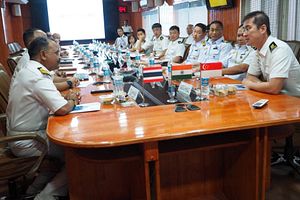This week, India finally hosted a trilateral maritime exercise that it had been mulling with Singapore and Thailand. As the exercise continues to be held through this week, it deserves attention both on its own terms as well as within the context of broader trends in the Indo-Pacific region.
As I have noted before in these pages and elsewhere, as India under Prime Minister Narendra Modi has expanded its ties with Southeast Asia via the so-called Act East Policy, we have seen some developments take shape in the defense realm as well. Over the past few years, India attempted to boost bilateral security ties with a number of individual Southeast Asian states as well as multilateralize some arrangements as well amid the increasing attention to the Indo-Pacific as a strategic space. While the progress has been uneven and slow, the gains have been noticeable, be it new exercises with Malaysia and Myanmar, an agreement with Singapore on logistics support, and a defense credit line extended to Vietnam.
One of the instances of this had been the idea of a first trilateral exercise between Singapore, India, and Thailand. The idea had first received public attention when Indian Prime Minister Narendra Modi included it in his 2018 keynote address to the Shangri-La Dialogue, Asia’s premier security summit, back in June 2018. In that speech, Modi had made reference to further multilateralizing India’s defense arrangements with Southeast Asian countries and including more of them in India’s defense initiatives in the Indian Ocean.
This week, we finally saw the inaugural iteration of what has been referred to as the Singapore-India-Thailand Maritime Exercise (SITMEX) get underway after some delay. The exercise involving the Republic of Singapore Navy, the Indian Navy, and the Royal Thai Navy, kicked off on September 16 and is scheduled to last until September 20.
The exercise, hosted by India, comprises various components. Per official accounts of the exercise, it includes a shore phase held at Port Blair, which will involve exercise planning and professional exchanges, and a sea phase that features maneuvering, navigation, and gunnery drills, along with boarding operations, in the Andaman Sea. All in all, the exercise involves five ships from the three navies and roughly more than 500 exercise participants.
SITMEX is certainly not without significance. At a general level, it is a tangible demonstration of intra-Asian security networking at work in the Indo-Pacific region. More specifically, it illustrates that, despite the challenges that remain, India, along with other pivotal Southeast Asian states, continue to play an important role in operationalizing new instances of maritime collaboration, including in the Andaman Sea.
To be sure, an assessment of the full significance of SITMEX will likely have to await future steps that India and others will take. One indicator will be whether SITMEX will translate into an annualized exercise arrangement of some kind, which would make it a regular feature in the Indo-Pacific exercise calendar. Another is whether SITMEX will spur potential expansion – while there have been media reports suggesting that this could be broadened to include other countries including Malaysia and Singapore, such expansions of multilateral exercises can create their own challenges including coordination and sustainability that can be difficult to manage.
That does not detract from the significance of the holding of SITMEX itself. Indeed, as we continue to see intra-Asian security networking play out in the Indo-Pacific region, instances such of these deserve attention as tangible manifestations of a general trend.
































